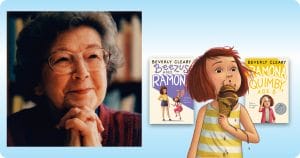Growing up in rural Yamhill, Ore., “The first grade was sorted into three reading groups,” Cleary said. “Bluebirds, Redbirds and Blackbirds. I was a Blackbird. To be a Blackbird was to be disgraced. I wanted to read, but somehow could not.” But once she could read, she found books for her age range were boring, the stories simple and uninspiring. “I no longer wanted to read,” she said later. “I disliked books in which children learned to be ‘better’ children.” Why didn’t authors write books about ordinary children, she wondered — and with humor? Finally she found such a book (The Dutch Twins by Lucy Fitch Perkins*), and it was a revelation. Her sixth-grade teacher, impressed with her stories, suggested she be a children’s book author. Instead she decided to become a librarian, specifically to help children find books they would like. The problem: there just weren’t that many.

She made up her own stories for the library’s story time, and finally decided to write them down. She became the writer her sixth grade teacher suggested. In 1950 her first book was published, Henry Huggins, which became a series. She based the stories on her own childhood, and what she learned about the children visiting the library. Not surprisingly, the kids could relate to the characters she invented. “When you’re the right age to read Cleary’s books you’re likely at your most impressionable time in life as a reader,” said children’s literature historian Leonard Marcus. Her books “both entertain children and give them courage and insight into what to expect from their lives.” Eliza Dresang, a professor at the University of Washington Information School, Cleary’s alma mater, agrees. Cleary’s books, she said, “don’t seem so radical now, but they were when she was writing them.” Children’s books have been “expanding in terms of the topics they’ll cover, the honesty, the accuracy, the ability to portray real-life children,” she said in 2008. “Well, Beverly Cleary was doing that 50 year ago.” To give you an idea as to Cleary’s influence in the field, Dresang wasn’t just a professor at the University of Washington’s Information School (formerly the Graduate School of Library and Information Sciences); in 2008 she was named the Beverly Cleary Professor in Children and Youth Services.
In 1975, Cleary won the Laura Ingalls Wilder Award from the American Library Association for her “substantial and lasting contributions to children’s literature.” In 2000, she was named a Living Legend in the writers and artists category for her contributions to the cultural heritage of the United States by the Library of Congress, and she received the National Medal of Arts in 2003. Meanwhile, her books have sold more than 85 million copies. “Nothing in the whole world felt as good as being able to make something from a sudden idea,” she said of her life. “If you don’t see the book you want on the shelves, write it.” Cleary died March 25 at a retirement home in Carmel-by-the-Sea, Calif. She was 104.
